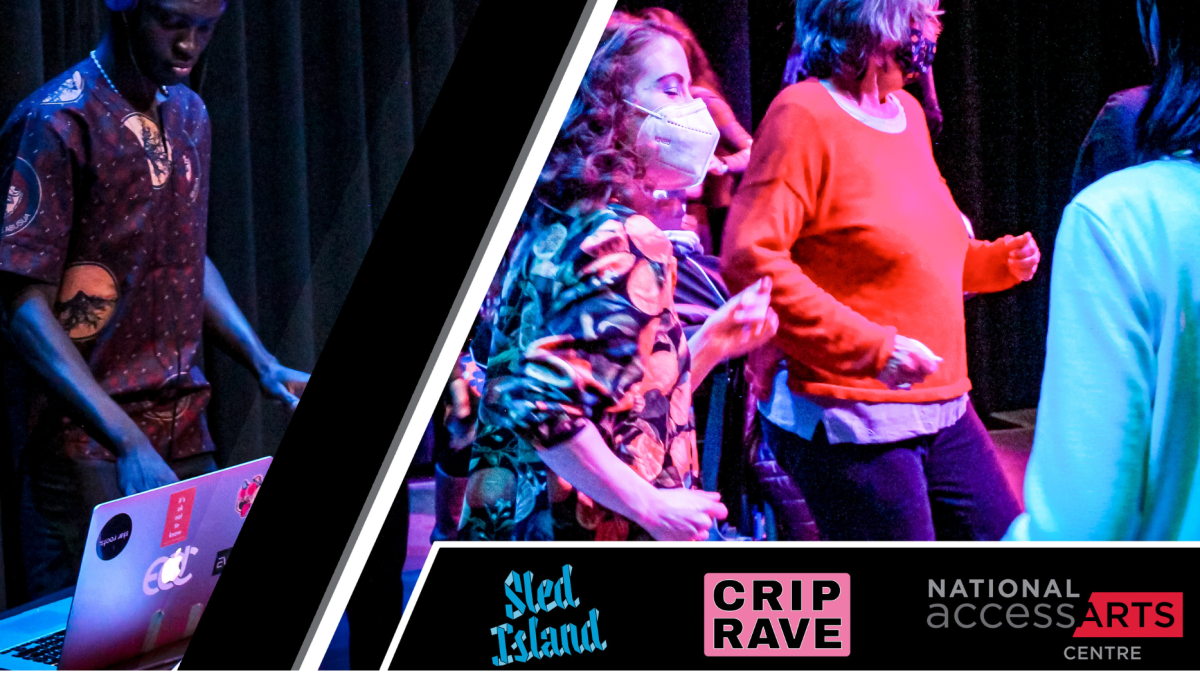As told by the National accessArts Centre (NaAC) music ensemble a.k.a. The Science Fiction People
Every music producer has their own production process. It’s what makes our musical landscape so rich and diverse. But for too long, one critical perspective has been left out: that of crip-identifying creators, producers, musicians, and composers.
“A lot of music programs for folks living with disabilities are therapeutic based, so there’s always a function to the music. The use of music is always tied to some sort of outcome, like learning to tie your shoes or remembering to brush your teeth.”
Clayton Smith, Lead, Programs & Exhibitions, NaAC
Wanting to give artists the means to create and express themselves through music, the NaAC formed a five-piece music ensemble. Though they had little-to-no experience in musical composition, they shared a love and natural inclination for music–especially pop. For 12 months, David Oppong, Mark Bedford, Tony Goodison, Colleen Ashmore, and Jan De La Cruz met every week to create a 10-track digital album. They called themselves The Science Fiction People.
Five stages of music production
Here, Clayton shares what he knows – and what he learned from working with the ensemble – about the 5 stages of music production.
Stage 1: Composition
Composition: the process of creating melodic, harmonic, and rhythmic ideas. Composition involves experimenting with different sounds, and identifying the core musical elements of a song.
Learning to play an instrument can take years, says Clayton. “With conventional instruments and traditional standards, it can take anywhere from 3 to 5 years before musicians feel comfortable and confident with their instruments.”
Not wanting to stand in the way of creative expression, Clayton turned to Blurring the Boundaries, a Montreal-based organization that experiments with accessible digital music technology and advocates for disabled musicians to be recognized as leaders, technical innovators, creators, and musical performers.
Together, they set out to find an online platform that would allow the ensemble to collaborate and experiment in real time, without too much emphasis on traditional Western musical knowledge and experience. They landed on Soundtrap, an online digital audio workstation (DAW) that enables users to easily explore new sounds, create songs, and collaborate with each other remotely.
“Soundtrap provided a really large database of samples–pre-made beats and presets–that the artists could sift through to find sounds they liked, and still work with things like harmony, melody, and rhythm, without having to actually play any instruments,” says Clayton. “It gave them immediate access to different forms of musical expression.”
After a series of workshops to familiarize themselves with the software, members of the ensemble chose sounds, melodies, and chord progressions that felt right, and expressed the mood or aesthetic they were going for. Next, they put them in order.
Stage 2: Arrangement
Arrangement: the process of assembling a song’s structure; laying out musical ideas along a timeline to build a complete musical piece. Arrangement is a complex process that aims to create a sense of flow and momentum through intros, verses, bridges, choruses, breakdowns, and outros.
Once the artists had identified the core musical elements of their songs, they set out to structure them in a way that would catch–and keep–their listeners’ attention.
It’s important for a song to evoke emotions and build energy, says Clayton. “We tried as much as possible to relate each song’s structure back to a narrative of some sort; to connect it to a story. If the chorus gives listeners the full message, the verses build upon that message, and so on.”
The artists took a deep dive into song structure, analyzing some of their favourite songs on YouTube to understand how each element supports the overall narrative. They learned arrangement techniques and pop music tricks. And, after they collectively arranged a song, they set it aside and started work on another.
With demo versions of all 10 songs complete, they exported the “stems” (individual stereo tracks for each instrument in the arrangement) and sent them to a local producer to put the finishing touches on their creations.
Stage 3: Production
Production: the final stage before focusing on mixing. Production involves filling in the arrangement, fixing any issues, and making final creative decisions.
Throughout the project, Clayton invited several guest producers from Calgary’s vibrant music community to work with the ensemble.
“It was important to introduce the ensemble to new, creative ways of working and to demonstrate that there’s not one right way to write or make songs,” he says. While each provided a unique and valid perspective, one in particular struck a chord.
Dyllan Mills-Harten is a 27-year-old, up-and-coming musician, arranger, and composer living with cerebral palsy in Calgary. He’s been making waves in the music industry as a composer fighting with academia and social media in creative solidarity with other disabled composers.
“He’s an incredibly talented artist,” says Clayton. “After working with Dyllan, we knew we needed him to be involved in a more substantial way, so we invited him to co-produce and arrange the entire project!”
Once he received the stems, Dyllan worked with each of the ensemble members to remix and rearrange their songs, all the while making sure they reflected what the artist intended. In the end, Dyllan and the ensemble compiled, co-arranged, and co-produced a complete 10-track digital album–a first for many of the artists involved, and a major step for the disability arts community.
Stage 4: Mastering
Mastering: the final stage in the music production process. Mastering is the post-production process of taking an audio mix or album and preparing it for distribution.
With the album complete, it was time to ready it for release. Together, Dyllan and Clayton met with Maddie McKay at OCL Studios, a world-class recording facility situated just outside of Calgary, to finalize the mixes and master the tracks.
It was an incredible experience, says Clayton, who was honoured to accompany Dyllan on his first trip to a professional music studio.
“He was just tickled pink to be sitting in a control room, which is exciting for any musician, but even more so for someone who didn’t necessarily see themselves being in a situation like that,” Clayton adds.
Together, they adjusted the equalization, compression, and saturation until the album reached the right volume from start to finish. “Robot Revelation” was ready.
Stage 5: Celebrating
Celebrating: the act of acknowledging a significant event with a social gathering or enjoyable activity.
The ensemble decided to celebrate the release of “Robot Revelation” their way: with a dance party. Together with CRIP RAVE collective (TO) and Sled Island, they hosted an accessible rave, a safe and welcoming gathering for crip-identifying body-minds to move to the music they created.
“We brought in a suite of DJs who identify as disabled or neuro-diverse to host a three-hour long dance party with a handful of accessibility features,” says Clayton.
Thanks to CRIP RAVE collective’s guidance, the event had an accessible venue, light and sound considerations, and ASL music interpretation. Songs from the album were incorporated into sets throughout the event. “It was very cool!” Clayton says.
Watch for Robot Revelation wherever you stream music. The album will also be available for download with royalties paid to the ensemble members.


